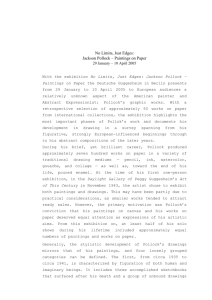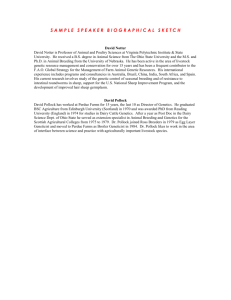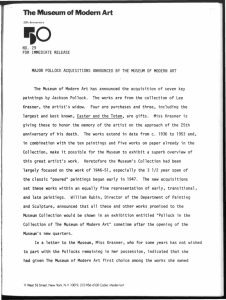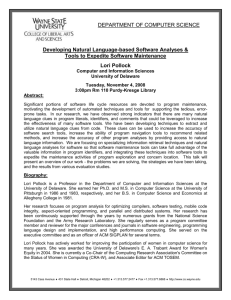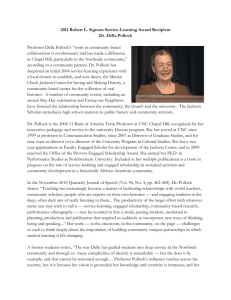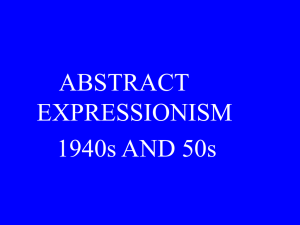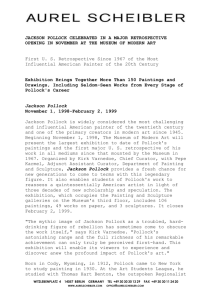Press release NO LIMITS, JUST EDGES: JACKSON POLLOCK
advertisement
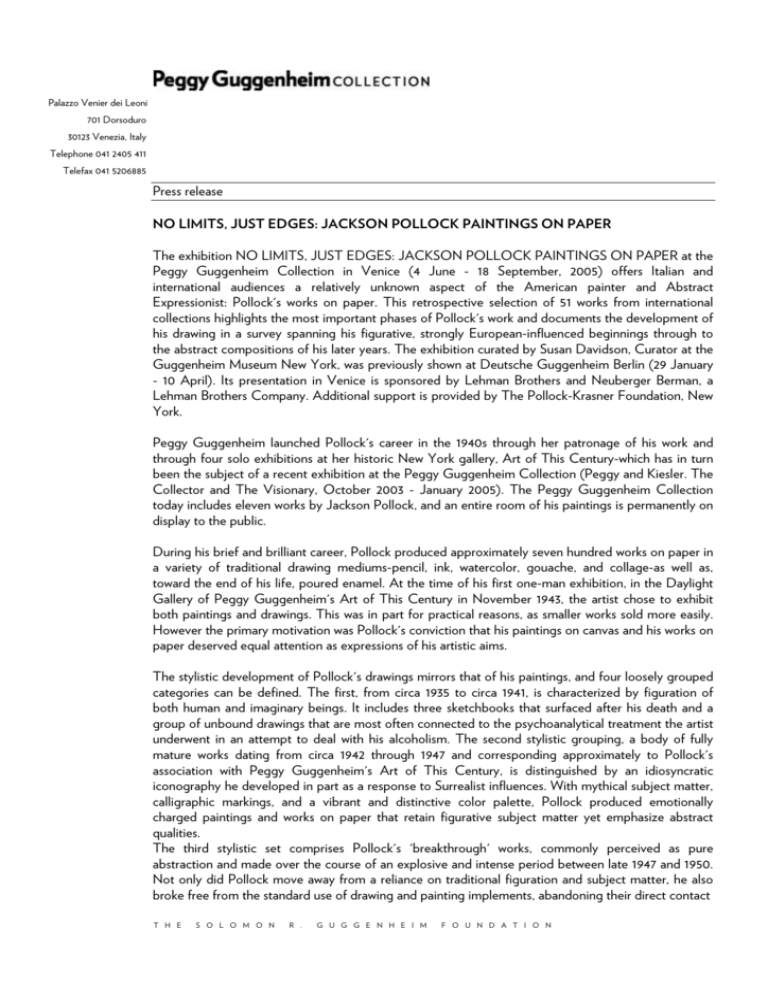
Palazzo Venier dei Leoni 701 Dorsoduro 30123 Venezia, Italy Telephone 041 2405 411 Telefax 041 5206885 Press release NO LIMITS, JUST EDGES: JACKSON POLLOCK PAINTINGS ON PAPER The exhibition NO LIMITS, JUST EDGES: JACKSON POLLOCK PAINTINGS ON PAPER at the Peggy Guggenheim Collection in Venice (4 June - 18 September, 2005) offers Italian and international audiences a relatively unknown aspect of the American painter and Abstract Expressionist: Pollock's works on paper. This retrospective selection of 51 works from international collections highlights the most important phases of Pollock's work and documents the development of his drawing in a survey spanning his figurative, strongly European-influenced beginnings through to the abstract compositions of his later years. The exhibition curated by Susan Davidson, Curator at the Guggenheim Museum New York, was previously shown at Deutsche Guggenheim Berlin (29 January - 10 April). Its presentation in Venice is sponsored by Lehman Brothers and Neuberger Berman, a Lehman Brothers Company. Additional support is provided by The Pollock-Krasner Foundation, New York. Peggy Guggenheim launched Pollock's career in the 1940s through her patronage of his work and through four solo exhibitions at her historic New York gallery, Art of This Century-which has in turn been the subject of a recent exhibition at the Peggy Guggenheim Collection (Peggy and Kiesler. The Collector and The Visionary, October 2003 - January 2005). The Peggy Guggenheim Collection today includes eleven works by Jackson Pollock, and an entire room of his paintings is permanently on display to the public. During his brief and brilliant career, Pollock produced approximately seven hundred works on paper in a variety of traditional drawing mediums-pencil, ink, watercolor, gouache, and collage-as well as, toward the end of his life, poured enamel. At the time of his first one-man exhibition, in the Daylight Gallery of Peggy Guggenheim's Art of This Century in November 1943, the artist chose to exhibit both paintings and drawings. This was in part for practical reasons, as smaller works sold more easily. However the primary motivation was Pollock's conviction that his paintings on canvas and his works on paper deserved equal attention as expressions of his artistic aims. The stylistic development of Pollock's drawings mirrors that of his paintings, and four loosely grouped categories can be defined. The first, from circa 1935 to circa 1941, is characterized by figuration of both human and imaginary beings. It includes three sketchbooks that surfaced after his death and a group of unbound drawings that are most often connected to the psychoanalytical treatment the artist underwent in an attempt to deal with his alcoholism. The second stylistic grouping, a body of fully mature works dating from circa 1942 through 1947 and corresponding approximately to Pollock's association with Peggy Guggenheim's Art of This Century, is distinguished by an idiosyncratic iconography he developed in part as a response to Surrealist influences. With mythical subject matter, calligraphic markings, and a vibrant and distinctive color palette, Pollock produced emotionally charged paintings and works on paper that retain figurative subject matter yet emphasize abstract qualities. The third stylistic set comprises Pollock's 'breakthrough' works, commonly perceived as pure abstraction and made over the course of an explosive and intense period between late 1947 and 1950. Not only did Pollock move away from a reliance on traditional figuration and subject matter, he also broke free from the standard use of drawing and painting implements, abandoning their direct contact T H E S O L O M O N R . G U G G E N H E I M F O U N D A T I O N with the surface. Instead, he worked from distances above the picture plane, using dripping, pouring, and splattering techniques-methods that were not necessarily Pollock's invention alone but that he pushed to new extremes. The fourth and final group represents a refinement of Pollock's pouring techniques. The drawings are stylistically related to his works on canvas of the time, but whereas earlier drawings had a clear connection to larger canvases, these later drawings specifically exploit the qualities of working with fluid mediums on porous paper. Like the canvas paintings of 1950-52, these drawings exhibit a more open, light ground scattered with lyrical compositions of calligraphic forms. The last four years of Pollock's life-he died tragically in an automobile accident on 11 August, 1956-are almost devoid of drawings; correspondingly, his output of paintings also diminished. No Limits, Just Edges: Jackson Pollock Paintings on Paper includes loans from prestigious museums and private collections, such as the Metropolitan Museum of Art, New York; The Museum of Modern Art, New York; the Whitney Museum of American Art, New York; the Menil Collection, Houston; the National Gallery of Art, Washington, DC; the Museum of Contemporary Art, Los Angeles; the Solomon R. Guggenheim Museum, New York; the Scottish National Gallery of Modern Art, Edinburgh; El Museo de arte Thyssen-Bornemisza, Madrid. The exhibition catalogue is published in Italian, German and English editions. Essays by the curator and by David Anfam and Margaret Holben Ellis make the catalogue a valuable contribution to our understanding of Jackson Pollock's works on paper. This exhibition is sponsored by: Programs of the Peggy Guggenheim Collection are supported by the Advisory Board, the Banca del Gottardo, the Regione Veneto and: # 169, June 2005 T H E S O L O M O N R . G U G G E N H E I M F O U N D A T I O N
